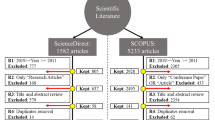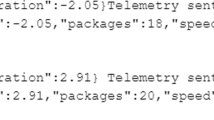Abstract
In maintenance systems, the current approach to workforce analysis entails the utilisation of metrics that focus exclusively on workforce cost and productivity. This method omits the “green” concept, which principally hinges on energy-efficient manufacturing and also ignores the production-maintenance integration. The approach is not accurate and could not be heavily relied upon for sound maintenance decisions. Consequently, comprehensive, scientifically-motivated, cost–effective and environmentally-conscious approaches are needed. With this in view, a deviation from the traditional approach through employing a combined fuzzy, quality function deployment interacting with three meta-heuristics (colliding bodies’ optimisation, big-bang big-crunch and particle swarm optimisation) for optimisation is made in the current study. The workforce size parameters are determined by maximising workforce size’s earned-valued as well as electric power efficiency maximisation subject to various real-life constraints. The efficacy and robustness of the model is tested with data from an aluminium products manufacturing system operating in a developing country. The results obtained indicate that the proposed colliding bodies’ optimisation framework is effective in comparison with other techniques. This implies that the proposed methodology potentially displays tremendous benefit of conserving energy, thus aiding environmental preservation and cost of energy savings. The principal novelty of the paper is the uniquely new method of quantifying the energy savings contributions of the maintenance workforce.





Similar content being viewed by others
References
Aghezzaf E, Khatab A, Tam PL (2016) Optimizing production and imperfect preventive maintenance planning’s integration in failure-prone manufacturing systems. Reliab Eng Syst Saf 145:190–198
Bagheri M, Bashiri M (2014) A hybrid genetic and imperialist competitive algorithm approach to dynamic cellular manufacturing system. Proc Inst Mech Eng Part B: J Eng Manuf 228(3):458–470
Belmokaddem M, Mekidiche M, Sahed AK (2009) Application of a fuzzy goal programming approach with different importance and priorities to aggregate production planning. J Appl Quant Meth 4(3):317–331
Biondia M, Sanda G, Harjunkoskia I (2015) Tighter integration of maintenance and production in short-term scheduling of multi-purpose process plants. Comput Aided Chem Eng 37:1937–1942
Bottani E (2009) A fuzzy QFD approach to achieve agility. Int J Prod Econ 119(2):380–391
Chin K-S, Wang Y-M, Yang J-B, Poon KKG (2009) An evidential reasoning based approach for quality function deployment under uncertainty. Exp Syst Appl 36:5684–5694
Coello CAC (2002) Theoretical and numerical constraint-handling techniques used with evolutionary algorithms: a survey of the state of the art. Comput Meth Appl Mech Eng 191:1245–1287
Cosgrove J, Duarte M-JR, Littlewood J, Wilgreroth P (2016) An energy mapping methodology to reduce energy consumption in manufacturing operations. Proc Inst Mech Eng Part B: J Eng Manuf. doi:10.1177/0954405416673101
Dai M, Tang D, Xu Y, Li W (2015) Energy-aware integrated process planning and scheduling for job shops. Proc Inst Mech Eng Part B: J Eng Manuf 229(51):13–26
Dat LQ, Phuong TT, Kao H-P (2015) A new integrated fuzzy QFD approach for market segments evaluation and selection. Appl Math Model 39:3653–3665
Duflon JR, Sutherland JW, Dornfeld D, Herrmann C, Jeswiet J, Kara S, Hauschild M, Kellens K (2012) Towards energy and resource efficient manufacturing: a process and system approach. CIRP Annals-Manuf Technol 61:587–609
Eberhart RC, Kennedy J (1995) A new optimizer using particle swarm theory. In: Proceedings of the sixth int symposium on micro-machine and human science, Nagoya, Japan
El-Baz MA (2011) Fuzzy performance measurement of a supply chain in manufacturing companies. Exp Syst Appl 38:6681–6688
Engelbrecht AP (2007) Artificial intelligence: an introduction. Wiley, New York
Erol OK, Eksin I (2006) New optimisation method: big-bang big-crunch. Adv Eng Soft 37:106–111
Faulkner W, Badurdeen F (2014) Sustainable value stream mapping (Sus-VSM): methodology to visualise and assess manufacturing sustainability performance. J Clean Prod 85:8–18
Felan JT, Fry TD (2001) Multi-level heterogeneous worker flexibility in a dual resource constrained (DRC) job-shop. Int J Prod Res 39(14):3041–3059
Fletcher SR, Baines TS, Harrison D (2008) An investigation of production workers’ performance variations and the potential impact of attitudes. ]nol 35(11–12):1113–1123
Ghani et al (2012) Energy optimisation in manufacturing systems using initial engineering-driven discrete event simulation. Proc Inst Mech Eng Part B: J Eng Manuf 226(11):1914–1929
Hasani H, Tabatabaei SA, Amiri G (2012) Grey relational analysis to determine the optimum process parameters for open-end spinning yarns. J Eng Fibers and Fabrics 7(2):81–86
Holland JH (1975) Adaptation in natural and artificial systems. University of Michigan Press, Ann Arbor
Ighravwe DE, Oke SA (2014) A non-zero integer non-linear programming model for maintenance workforce sizing. Int J Prod Econ 150:204–214
Karsak EE (2004) Fuzzy multiple objective programming framework to prioritise design requirements in quality function deployment. Comput Ind Eng 47(2–3):149–163
Kaveh A, Ghazaan MI (2014) Computer codes for colliding bodies optimisation and its enhanced version. Int J Opt Civil Eng 4(3):321–339
Kaveh A, Mahdavi VR (2014a) Colliding bodies optimisation: a novel meta-heuristic method. Comput Struct 139:18–27
Kaveh A, Mahdavi VR (2014b) Colliding bodies optimisation for design of arch dams with frequency limitations. Int J Opt Civil Eng 4(4):473–490
Kirkpatrick S, Gelett CD, Vecchi MP (1983) Optimisation by simulated annealing. Science 220:621–630
Luna-Junior FR, Carpinetti LCR (2016) A multi-criteria approach based on fuzzy QFD for choosing criteria for supplier selection. Comput Ind Eng 101:269–285
Maniraj M, Pakkirisamy V, Jeyapaul R (2015) an ant colony optimisation-based approach for a single-product flow-line reconfigurable manufacturing systems. Proc Inst Mech Eng Part B: J Eng Manuf. doi:10.1177/0954405415585260
Mekidiche M, Belmokaddem M, Djemmaa Z (2013) Weighted additive fuzzy goal programming approach to aggregate production planning. Int J Intell Syst Appl 4:20–29
Narayanan RG, Das S (2014) Sustainable and green manufacturing and materials design through computations. Proc Inst Mech Eng Part C: J Mech Eng Sci 228(9):1581–1605
Nourelfath M, Nahas N, Ben-Daya M (2016) Integrated preventive maintenance and production decisions for imperfect processes. Reliab Eng Syst Saf 148:21–31
Onar SC, Buyukozkan G, Oztaysi B, Kahraman C (2016) A new hesitant fuzzy QFD approach: an application to computer workstation selection. Appl Soft Comput 46:1–16
Pang Y, Xia H (2016) a hybrid modeling and optimisation approach for scheduling problems of assembly automation processes. Proc Inst Mech Eng Part I: J Syst Cont Eng 230(8):778–785
Ramanathan R, Yunfeng J (2009) Incorporating cost and environmental factors in quality function deployment using data envelopment analysis. Omega 37:711–723
Rao RV, Savsani VJ, Vakharia DP (2011) Teaching-learning-based optimisation: a novel method for constrained mechanical design optimisation problem. Comput Aided Des 43:303–315
Sahu SK, Datta S, Patel SK, Mahapatra SS (2013) Supply chain performance appraisement, benchmark and decision-marking: empirical study using grey theory and grey-MOORA. Int J Process Manag Benchm 3(3):233–289
Storn R, Price K (1997) Differential evolution: a simple and efficient heuristic for global optimisation over continuous spaces. J Glob Opti 11:341–359
Techawiboonwong A, Yenradee P, Das SK (2006) A master scheduling model with skilled and unskilled temporary workers. Int J Prod Econ 103(2):798–809
Vinodh S, Chintha SK (2011) Application of fuzzy QFD for enabling leanness in a manufacturing organisation. Int J Prod Res 49(6):1627–1644
Wang R-T (2007) Improving service quality using quality function deployment: the air cargo sector of China airlines. J Trans Manag 13:221–228
Wu Z (2008) Hybrid multi-objective optimisation models for managing pavement assets. Thesis Ph.D. Virginia Polytechnic Institute and State University, Department of Civil and Environmental Engineering
Yan H-B, Ma T (2015) A group decision-making approach to uncertain quality deployment based on fuzzy performance relation and fuzzy majority. Eur J Oper Res 241(3):815–829
Yang X-S (2009) Firefly algorithm for multimodal optimisation, In: Stochastic algorithm: foundations and application, SAGA, Lecture Note in Computer Science, 5792, 169–178
Yue H, Slomp J, Molleman E, van Der Zee DJ (2007) Worker flexibility in a parallel dual resource constrained job shop. Int J Prod Res 46(2):1–17
Zandi F, Tavana M (2011) A fuzzy group quality function deployment from e-CRM framework assessment in agile manufacturing. Comput Ind Eng 61(1):1–19
Zhang J-Q, Sanderson AC (2009) JADE: adaptive differential evolution with optimal external archive. IEEE Trans Evol Comp 13(5):945–958
Zhang X, Wang S, Yi L, Xue H, Yang S, Xiong X (2016) An integrated ant colony optimisation algorithm to solve job allocating and tool scheduling problem. Proc Inst Mech Eng Part B: J Eng Manuf. doi:10.1177/0954405416636038
Author information
Authors and Affiliations
Corresponding author
Appendix
Appendix
1.1 Section A
-
1.
What is the number of products produced?
-
2.
What is the average weekly production volume of each product?

-
3.
Do your company outsource production activities?
-
4.
If yes, what is the average weekly volume of each product that is outsourced?

-
5.
What is the unit cost of outsourced product?

1.2 Section B
In this section, information on evaluation of the performance of a production system is required. The set of selected questions are presented below, while the rating system for these questions is given as follows:
Grade | Interpretation |
|---|---|
Low | Less than 40% |
Medium | 41–60% |
High | 61–80% |
Very high | Above 80% |
S/n | Questions for responses | Low | Medium | High | Very high |
|---|---|---|---|---|---|
1 | How will you rate production workers idle time in your company? | ||||
2 | How will you rate maintenance workers idle time in your company? | ||||
3 | How will you rate machine efficiency in your company? | ||||
4 | How will you rate machine utilisation in your company? | ||||
5 | How will you rate machine availability in your company? | ||||
6 | How will you rate machine reliability in your company? | ||||
7 | How will you rate production workers efficiency in your company? | ||||
8 | How will you rate maintenance workers utilisation in your company? | ||||
9 | How will you rate maintenance workers efficiency in your company? | ||||
10 | How will you rate production workers utilisation in your company? | ||||
11 | How will you rate workers turnover rate in your company? | ||||
1.3 Section C
In this section, the range of some resources used during weekly production activities is required. Kindly assist us in providing information for the following set of questions:
S/No. | Questions for responses |
|---|---|
1 | What is the range of weekly full-time production workers? |
2 | What is the range of weekly full-time maintenance workers? |
3 | What is the range of weekly causal production workers? |
4 | What is the range of weekly causal maintenance workers? |
5 | What is the range weekly production? |
6 | What is the range of weekly breakdown time? |
7 | What is the range of weekly production cost? |
8 | What is the range of weekly maintenance cost? |
9 | What is the range of weekly cost of spares? |
10 | What is the range of weekly workforce cost/? |
12 | What is the range of weekly maintenance? |
13 | What is the range of weekly production time? |
Rights and permissions
About this article
Cite this article
Ighravwe, D.E., Oke, S.A. A manufacturing system energy-efficient optimisation model for maintenance-production workforce size determination using integrated fuzzy logic and quality function deployment approach. Int J Syst Assur Eng Manag 8, 683–703 (2017). https://doi.org/10.1007/s13198-016-0555-7
Received:
Revised:
Published:
Issue Date:
DOI: https://doi.org/10.1007/s13198-016-0555-7




